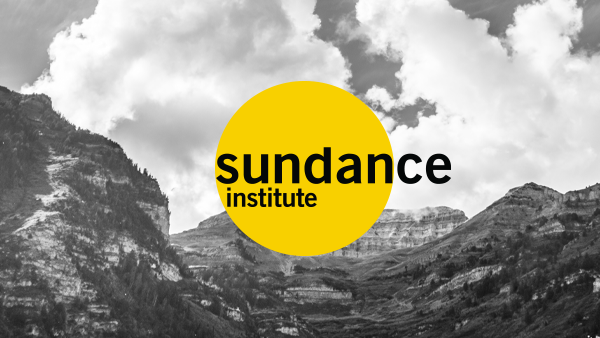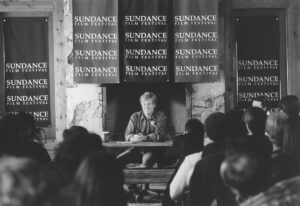Eric Hynes, Jeremy Kinser, and Nate von Zumwalt
Sundance.org is dispatching its writers to daily screenings and events to capture the 10 days of festivities during the Sundance Film Festival in Park City, Utah. Check back each morning for round-ups from the previous day’s events.
Day One Press Conference
By Nate von Zumwalt
There was a moment at Thursday’s Day One Press Conference that encapsulated both the immense growth of the Sundance Film Festival over its 29-year existence and its unwavering loyalty to artists and audiences.
“Hey Coop, remember when this was simple?,” quipped Sundance Institute President and Founder Robert Redford. Only just getting settled on-stage at Park City’s iconic Egyptian Theatre, Festival Director John Cooper chuckled, and then offered a frank rebuttal: “No…”
Redford and Cooper have collaborated on the Festival since 1989, when the latter began his stint with the programming department at Sundance. Since that time, submissions have skyrocketed exponentially, technology has transformed the craft of filmmaking, and Sundance has ascended to its premier position in the hierarchy of film festivals. But, as Sundance Institute Executive Director Keri Putnam hinted, the films are as fiercely independent as ever and Sundance remains a Festival for filmmakers and audiences.

“The movies are most exciting. It’s a Festival of discovery. We have 51 films from new filmmakers, and 22 have come through our Sundance Institute Labs,” said Putnam.
Echoing that sentiment–and acknowledging an emergence of established filmmakers in recent years–Cooper expressed his pleasure in programming a diverse lineup of newcomers and experts. “I love the notion of established filmmakers mixing with the 51 first-timers,” he said. “I think there’s a magic to that; I think it’s part of the alchemy that makes the Sundance Film Festival really special.”
In past years, the Day One Press Conference has served as a platform to address changes in the Festival structure, from category tweaks (NEXT expands from 8 to 10 films this year) to new twists on classic programming (KCRW DJs will curate three nights of live music at Music Café). The 2013 Festival sees less of these formal changes, and sensing Redford, Putnam, and Cooper’s collective tone, they’re just fine with continuing to polish what they do best.
“We’ve grown,” said Putnam. “We’re in 13 different countries all over the world. It’s a rich time for the Institute and the program really reflects that.”
Redford sees change through a different lens, but nonetheless recognizes the importance of continuing to nourish the mission that is the heart of Sundance.
“When you think about art, you think about film. And you can use it as an agent for change. As long as we go forward and adapt to change, we keep with our original purpose.”
Who Is Dayani Cristal?
By Eric Hynes
As the sun settled behind the mountains on this crisp January evening, the Festival began in earnest at the MARC Theater with the first screening of 2013, Who Is Dayani Cristal. Featured in the World Cinema Documentary Competition, the film pieces together the story of an unknown man whose corpse was discovered in the Arizona desert in August of 2010. Director Marc Silver pursues two distinct but invaluable strategies for illuminating the mystery of a man whose only identifying mark was a chest tattoo bearing the words “Dayani Cristal.” One is a firsthand, procedural account of the investigation by medical examiners and border police, who have found that deaths related to illegal immigration have increased tenfold over the past decade; the other is a fictionalized retracing of the man’s steps—from rural Guatemala to train-hopping through Mexico to the other side of the U.S. border—with actor and producer Gael Garcia Bernal playing the part of the migrant seeking opportunity in America.

“In a crude filmic way, one of our major problems was that our main character was not alive,” explained Silver during the post-screening Q&A. “But the whole point of the project was to try and humanize the icon of the alien criminal, and the best way of doing that was to act out the living part of the journey.” Their novel solution was to devise the Bernal sequences, which are less of a re-enactment than a speculative parallel journey, with the actor serving as our conduit for the arduous path that thousands of migrants take every year.
“Perhaps we’re very limited in a sense of how to define what’s supposed to be the fiction, which in reality is perhaps one of the more spontaneous documentary pieces in the film,” said Bernal. “We never took it as a reenactment, because we wanted to play with this in a more thematic and philosophical way—how to play around with the otherness.” Instead of blending into the itinerant communities where these sequences were shot, Bernal was recognized a majority of the time—something that he considered a blessing. “For some reason they let us play into the game. They let us live this with them. They wanted to show their journey,” he recalled. “And they also wanted to be shot by the camera, so that their families could know that they’re okay. Because from the beginning it’s a very underground journey.”
Crystal Fairy
By Eric Hynes
While Who Is Dayani Cristal retraces the tragic path of a South American man into the United States, World Dramatic Competition entry Crystal Fairy (no relation) chronicles the comedic passage of a young Yank into a remote area of South America, namely the coastal desert of Chile. Michael Cera plays Jamie, an ex-pat post-grad who recruits his roommate and his roommate’s two brothers (played by director Sebastián Silva’s three brothers, Agustín, José, and Juan) on an expedition to locate, obtain, cook, and imbibe the San Pedro cactus, a fabled indigenous source of the psychedelic mescaline. Along the way they’re joined by a wild-eyed American neo-hippie who goes by the name of Crystal Fairy (Gaby Hoffman), who changes the dynamics of the group—at first to everyone’s, and particularly Jamie’s, frustration, but eventually for the better.

“This really happened ten years ago. I went with my best friend down to the desert to take that cactus, and I invited Crystal Fairy along,” Silva said during the post-screening Q&A. “There wasn’t the type of tension that there is in the film between Jamie and Crystal, but pretty much everything else actually happened.” After sitting on the story for years, Silva started with just an outline based on that personal experience, and over the course of the 12-day shoot encouraged his actors improvise their dialogue. For the Silva boys and Cera, who had been living with the family and learning Spanish in preparation for Magic Magic—another Silva film that debuts later in the Festival—there was at least a baseline of rapport. But for Hoffman, who agreed to accept the role just days before shooting started in Chile, it was a much greater leap.
“I said I’ll do anything you want, but I don’t know how to improvise,” Hoffman said, though judging from her bold performance, in which she exudes both great confidence and emotional and physical vulnerability, she was clearly a quick learner. Since her character was based on a real person, she was able to immerse herself in aspects of New Age culture. “I was really afraid of making her a cliché. I wanted you to feel her personality beyond her façade. Her sadness, her struggle,” she said. For Silva, what was most important about the story, “is the lesson that Jamie learns, which is crying for someone else’s pain. That was what I learned with Crystal Fairy. To feel compassion. It’s the birth of compassion in someone’s life.”
Ten years later, Silva said he hasn’t been able to locate the woman who became the inspiration for the film. “This movie is dedicated to the real Crystal Fairy,” he said. “I hope she finds out [about the film], and reaches out.”
May in the Summer
By Jeremy Kinser
Cherien Dabis admitted to being a little freaked out while speaking on stage prior to the premiere of her sophomore directorial feature May in the Summer, which also marks her first starring role in front of the camera. She had little reason to be worried. As Festival Director John Cooper noted when introducing her, the director stepped in front of her own camera to “glorious effect.”
Dabis, who had a short film in the festival in 2007 and made a huge splash in 2009 with the drama Amreeka, makes her third visit to Sundance with the brightly observed and consistently surprising culture clash comedy about a mother and daughter forced to come to terms with each other’s choices. The filmmaker informed the packed audience at the Eccles Theatre that it felt like a homecoming. “I’m welcomed with open arms and so much love and so much support,” she said. “I can honestly say I’m one of those filmmakers who would probably not have a career without the Sundance Institute.” She informed the crowd that she developed the May in the Summer screenplay through Sundance’s Feature Film Program.

Considering the plot of the film it’s not surprising that Dabis also gave a special shout out to her mother, who was in the audience having traveled here from Jordan. The filmmaker thanked her want for opening her home to the crew for 10 days. Dabis had the crowd in laughs when she recounted a story about her previous Sundance experience. “When I first found out I got into Sundance in 2009 I called my mom and said, “Mom, Amreeka got into Sundance.” Her mother enthusiastically replied, “Oh my God, Cherien! That is so exciting. What is Sunny Dance?” Dabis looked at the full auditorium and informed her mother “This is Sunny Dance.” Dabis closed her opening remarks by thanking the audience for coming to the premiere of her comedy, adding, “The movie is incomplete without an audience and you are here completing my journey.”
Twenty Feet from Stardom
By Jeremy Kinser
“You’re in for such a hot night,” John Cooper informed the crowd at the Eccles Theatre as he introduced the world premiere of Morgan Neville’s stirring documentary Twenty Feet from Stardom. That would prove to be the understatement of the evening.
The audience was immediately hooked on Neville’s look at the personal journeys of backup singers such as Darlene Love, Merrie Clayton, Lisa Fischer, and Judith Hill. It’s a group of women who for various reasons never broke through to solo stardom. Music legends including Mick Jagger, Bruce Springsteen, Sting, and Bette Midler pay testament to the immense talent of the women.

After Jagger touted Clayton’s powerful work on the Rolling Stones’ famous 1969 recording “Gimme Shelter,” her isolated backing track was heard to stunning effect, inciting the audience to erupt in spontaneous applause. Perhaps the most rousing story is that of Love. After the vocalist parted ways with her mentor Phil Spector, she was reduced to working as a cleaning lady before making a comeback, thanks in part to an annual holiday appearance on Late Night with David Letterman. Love was inducted into the Rock and Roll Hall of Fame by Midler in 2011.
Following a standing ovation, Neville returned to the stage where he was joined by Clayton, Hill, and Vega during the Q&A. It didn’t take much coaxing for the ladies to sing for the appreciative crowd. Hill, who sang what she called “a church song,” informed the audience that she is still pursuing a solo career and hopes to release her first album later this year. But it was Clayton who largely stole the show during the Q&A. Her admonishment of “Why ya’ll leaving?” to a few patrons making an early exit during her remarks drew laughs from the still-packed house.
An Artist at the Table
By Nate von Zumwalt
There is no event at the Sundance Film Festival that more powerfully conveys the sequence of support that fuels Sundance Institute and its artists than An Artist at the Table. Just as artists look to Sundance for assistance, the Institute relies on the generosity of individuals who believe that the world around us is illuminated and enriched by authenticity and diversity in storytelling.
As part of the lively slate of Day One activities, select members of Sundance Institute’s Patron Circle, the Utah Advisory Board, and 2013 Festival artists gathered at New Frontier at The Yard for a cocktail reception to celebrate the creative and financial contributions that support the non-profit Sundance Institute and the Sundance Film Festival.
Attendees were treated to an exclusive preview of the New Frontier space, including a mind-warping planetarium installation from Lynette Wallworth (CORAL: Rekindling Venus) and a cutting-edge augmented reality piece by Yung Jake (E.m-bed.de/d.)
Festival Director John Cooper and Sundance Institute Utah Advisory Boar Chair Rory Murphy capped off the reception with a few words of gratitude toward the patrons in attendance.
“All of the patrons and sponsors of Sundance Institute, thank you all for being part of this, you make what we do possible 360 days of the year…,” said Cooper. A noticeable rumbling emanated from just to the side of Cooper’s makeshift podium, “365!”
On that note, Murphy inherited the microphone and offered a sage suggestion to all in attendance. “Take the time if you would, please, to thank a volunteer. Just go over and say, ‘Thanks very much.’ We do not have a Festival without them.”




